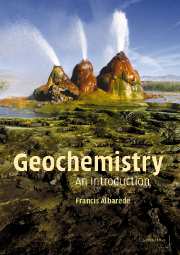Book contents
- Frontmatter
- Contents
- Foreword to the English edition
- Foreword to the French edition
- Acknowledgments
- Introduction
- 1 The properties of elements
- 2 Mass conservation – elemental and isotopic fractionation
- 3 Geochronology and radiogenic tracers
- 4 Element transport
- 5 Geochemical systems
- 6 Waters present and past
- 7 Mineral reactions
- 8 The solid Earth
- 9 The Earth in the Solar System
- 10 The geochemical behavior of selected elements
- Appendix A Composition of the major geological units
- Appendix B The mixing equation for ratios
- Appendix C A refresher on thermodynamics
- Appendix D The Rayleigh distillation equation
- Appendix E The geological time scale
- Appendix F An overview of analytical methods
- Appendix G Physical and geophysical constants
- Appendix H Some equations relative to residence time
- Further reading
- Index
9 - The Earth in the Solar System
- Frontmatter
- Contents
- Foreword to the English edition
- Foreword to the French edition
- Acknowledgments
- Introduction
- 1 The properties of elements
- 2 Mass conservation – elemental and isotopic fractionation
- 3 Geochronology and radiogenic tracers
- 4 Element transport
- 5 Geochemical systems
- 6 Waters present and past
- 7 Mineral reactions
- 8 The solid Earth
- 9 The Earth in the Solar System
- 10 The geochemical behavior of selected elements
- Appendix A Composition of the major geological units
- Appendix B The mixing equation for ratios
- Appendix C A refresher on thermodynamics
- Appendix D The Rayleigh distillation equation
- Appendix E The geological time scale
- Appendix F An overview of analytical methods
- Appendix G Physical and geophysical constants
- Appendix H Some equations relative to residence time
- Further reading
- Index
Summary
The speed at which the universe is expanding as measured by the “red shift” of light from the stars indicates that the Big Bang occurred about 15 billion years ago. Because our star, the Sun, is a mere 4.5 billion-year old youngster, it is clear that the Solar System recycles chemical elements with a long history. These elements form in stars by a combination of processes of thermonuclear fusion, nucleon absorption, and radioactive decay. Who would think that our warm sunshine is actually the output of the largest nuclear reactor for light years around? The processes leading to the formation of elements are known collectively as nucleosynthesis.
The formation of elements
The most abundant element in the universe is hydrogen, an element formed by an electron orbiting around a single proton. Let us begin with the formation of a Sun-like star by gravitational collapse of an interstellar nebula, a cloud of gas and dust. The Sun itself, which makes up 98% of the total mass of the Solar System, consists of 71% H, 27% He, and 2% of heavier elements. The composition of the Solar System is given by spectroscopic analysis of sunlight, and it is this composition that will concern us here (Fig. 9.1). The accumulation of potential energy released by the collapse of the star's enormous mass raises the elements at its center to extremely high temperatures, typically several million K, until thermal agitation prevents further contraction.
- Type
- Chapter
- Information
- GeochemistryAn Introduction, pp. 165 - 190Publisher: Cambridge University PressPrint publication year: 2003



